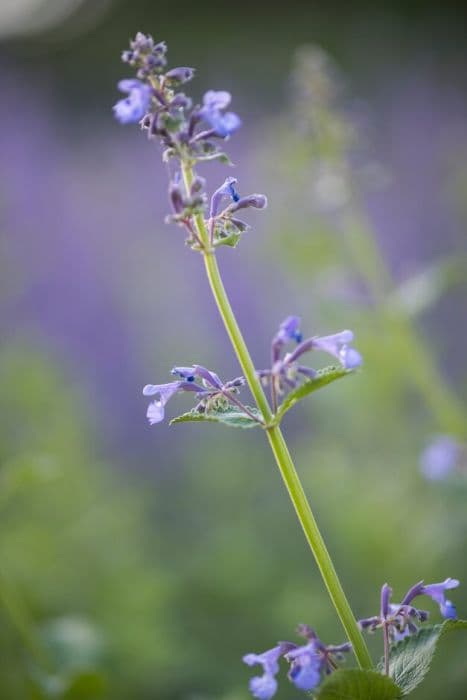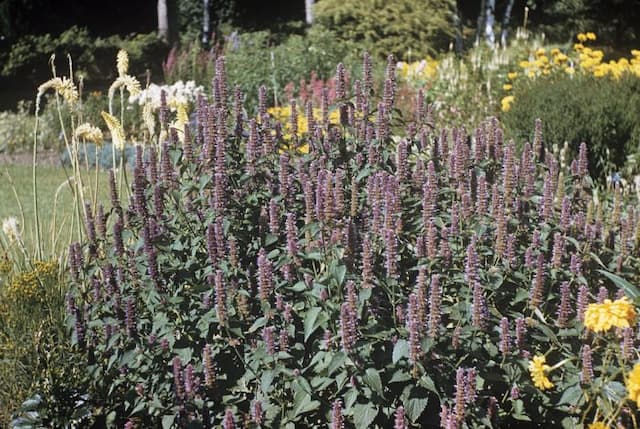Catmint Nepeta 'Rae Crug'

ABOUT
Nepeta 'Rae Crug' is a vibrant plant commonly known as catmint. It flaunts a lush mound of aromatic foliage, with leaves that are small, delicate, and often have a gray-green hue, edged with a fine fringe. This foliage provides a soft, textured backdrop for a bountiful display of blossoms in a bloom season that extends across the warmer months. The flowers themselves are tubular and arranged in dense whorls; they have a lilac to lavender color, which adds a cool and calming effect to the garden. These blossoms are adored by bees and butterflies, making the plant not only a visual treat but also a haven for these beneficial pollinators. The overall form of the plant is rounded and bushy, giving it a neat yet informal appearance, which makes it versatile for various garden settings. Although specifics about the plant's size have been excluded, it's important to note that catmint generally has a clumping habit and its growth is often dense, forming substantial coverage over the ground it occupies. The plant is prized for its easy care and ability to flourish under various conditions, making it a favorite among gardeners looking to add a touch of hardy elegance to their outdoor spaces.
About this plant
 Names
NamesSynonyms
Catmint, Catnip
Common names
Nepeta 'Rae Crug'
 Toxicity
ToxicityTo humans
The plant commonly known as catmint, including the variety Nepeta 'Rae Crug', is not generally considered toxic to humans. While it is not intended for consumption, incidental ingestion of small amounts typically does not result in poisoning or serious health consequences.
To pets
Catmint, including the Nepeta 'Rae Crug' variety, is not toxic to most pets. In fact, it is famously attractive to cats due to a compound called nepetalactone that can cause behaviors similar to those displayed when they are exposed to catnip. Most cats enjoy catmint and experience temporary hyperactivity, purring, or rolling. It is not considered harmful, and any symptoms of excitement generally subside without any adverse health effects.
 Characteristics
CharacteristicsLife cycle
Perennials
Foliage type
Deciduous
Color of leaves
Green
Flower color
Purple
Height
2 feet [60 cm]
Spread
3 feet [91 cm]
Plant type
Herb
Hardiness zones
3
Native area
Caucasus
Benefits
 General Benefits
General Benefits- Attracts Pollinators: Nepeta 'Rae Crug', commonly known as catmint, draws bees, butterflies, and other beneficial insects due to its fragrant flowers.
- Drought Tolerant: Once established, catmint is quite drought-resistant, making it suitable for xeriscaping or low-water gardens.
- Low Maintenance: Catmint generally requires little care beyond occasional watering and pruning to keep it tidy and encourage repeated blooming.
- Aesthetic Appeal: With its soft, gray-green foliage and lavender-blue flowers, catmint adds a beautiful and soothing visual element to a garden.
- Deer and Rabbit Resistant: The aromatic properties of catmint tend to deter deer and rabbits, making it a good choice for gardeners dealing with these pests.
- Durable: Catmint can thrive in a variety of soil conditions and withstands trimming well, making it a reliable perennial for garden borders or walkways.
- Fragrance: The leaves and flowers of catmint emit a pleasant scent that can enhance the sensory experience of a garden space.
- Erosion Control: Because of its ability to spread and establish a deep root system, catmint can help prevent soil erosion in sloped areas.
- Culinary Uses: While not as commonly used as some herbs, catmint can be used in small quantities to flavor certain dishes.
- Companion Planting: Catmint can help deter certain pests and is often used in companion planting to benefit vegetables and other plants.
- Long Blooming Period: Catmint flowers for a long time from early summer into fall, offering color and interest throughout the growing season.
 Medical Properties
Medical PropertiesThis plant is not used for medical purposes.
 Air-purifying Qualities
Air-purifying QualitiesThis plant is not specifically known for air purifying qualities.
 Other Uses
Other Uses- Nepeta 'Rae Crug', commonly known as Catmint, can be used in floral arrangements for its attractive spikes of lavender-blue flowers that provide a delicate texture and a soft, airy appearance.
- Catmint can serve as a natural insect repellent when its leaves are crushed and rubbed on the skin, due to its natural aromatic oils which some insects find unpleasant.
- The plant can be used to create a low-maintenance and drought-tolerant garden border that provides a splash of color with minimal care.
- Catmint's resilience makes it an ideal ground cover in areas where other plants might struggle, as it can handle poor soil conditions and still thrive.
- The plant's dense growth habit can be utilized to prevent soil erosion on slopes or banks, as its root system helps to hold the soil in place.
- Crafters may use dried Catmint flowers in potpourri mixes to add a pleasant fragrance to drawers, closets, or rooms.
- The pleasant scent of Catmint can be used in homemade sachets or pillow inserts to encourage relaxation and comfort, though it should be noted they could attract cats if you have them.
- Gardeners can plant Catmint as a natural way to attract pollinators like bees, butterflies, and hummingbirds to their gardens, enhancing pollination of other plants.
- Catmint can be planted as a companion plant in vegetable gardens to help deter certain pests from more sensitive crops.
- The silver-green foliage of Catmint can be used to add contrast in garden design when paired with plants that have dark green or purple leaves.
Interesting Facts
 Feng Shui
Feng ShuiThe plant Nepeta 'Rae Crug', commonly known as Catmint, is not used in Feng Shui practice.
 Zodiac Sign Compitability
Zodiac Sign CompitabilityCatmint is not used in astrology practice.
 Plant Symbolism
Plant Symbolism- Relaxation: The common name for Nepeta 'Rae Crug' is Catmint, and just like its close relative catnip, it is known for its soothing and relaxing properties. Catmint can symbolize a state of calmness and tranquility.
- Happiness: Catmint is also associated with happiness due to its ability to elicit a playful response in cats, and its light, airy flowers can evoke a sense of joy and contentment in humans.
- Affection: As Catmint is beloved by cats, it has come to symbolize affection and the special bond between pets and their owners.
- Healing: Historically, Catmint was used for medicinal purposes, including aiding digestion and reducing fever. Therefore, it can symbolize healing and wellness.
 Water
WaterCatmint should be watered deeply and less frequently to encourage deep root growth; this is particularly important during its first growing season to establish roots. After establishment, catmint is drought tolerant and requires less water. Generally, aim to water catmint every 1 to 2 weeks, providing about 1 to 1.5 inches of water each time, or more if conditions are exceptionally hot and dry. Reduce watering during the fall to prepare the plant for dormancy. It's important not to overwater, as catmint prefers drier soils and overwatering can lead to root rot.
 Light
LightCatmint thrives in full sun, meaning it requires at least 6 hours of direct sunlight daily to flourish. The best spot for the plant is in an area where it can receive unfiltered sunshine throughout the day. However, in extremely hot climates, catmint can benefit from some afternoon shade to protect it from the most intense heat.
 Temperature
TemperatureCatmint is a hardy perennial that can typically withstand temperatures down to about -30°F and can handle summer heat up to about 90°F. The ideal growing temperature is within the range of 60°F to 75°F. Be aware of extreme temperature changes as catmint prefers a consistent range and can be affected by sudden frosts or heat waves.
 Pruning
PruningPruning catmint is important for maintaining its shape and promoting a second bloom. Cut back the plant by one-third after the first flush of flowers fades, usually in late spring or early summer. This encourages a denser foliage and a plentiful second bloom. It's often recommended to do a final pruning in later fall or early spring to help maintain its shape and remove any dead or spent growth.
 Cleaning
CleaningAs needed
 Soil
SoilCatmint 'Rae Crug' prefers well-draining soil with a pH range of 6.0 to 7.5. The best soil mix is one that contains equal parts of garden soil, peat moss, and perlite to ensure good drainage and aeration. Regular garden soil can be improved with organic material to enhance nutrient content.
 Repotting
RepottingCatmint 'Rae Crug' should be repotted every two to three years to refresh the soil and address potential root crowding. Spring is the best time to repot this perennial herb, as it prepares to enter its active growing season.
 Humidity & Misting
Humidity & MistingCatmint 'Rae Crug' is tolerant of a wide range of humidity levels and thrives in the average humidity found in outdoor garden environments. It does not require any special humidity adjustments when grown outdoors.
 Suitable locations
Suitable locationsIndoor
Grow Catmint 'Rae Crug' in bright light and well-draining soil.
Outdoor
Plant Catmint 'Rae Crug' in full sun to part shade in well-drained soil.
Hardiness zone
3-8 USDA
 Life cycle
Life cycleNepeta 'Rae Crug', commonly known as Catmint or Catnip, begins its life cycle with seed germination in spring, once the soil has warmed up sufficiently. After germination, the seedlings develop into vegetative plants with characteristic grey-green foliage and square stems, a growth stage that can last for several weeks to months. As the plant matures, it enters the flowering stage, typically in late spring to early summer, producing spikes of lavender to blue flowers that attract bees and butterflies. After pollination, the flowers develop into small, brown nutlet fruits containing seeds, marking the plant's reproductive stage. In autumn, the aerial parts of the plant die back with the onset of colder temperatures, while the root system remains dormant through the winter. The following spring, Nepeta 'Rae Crug' regrows from the rootstock, repeating its life cycle.
 Propogation
PropogationPropogation time
Spring to early summer
Propogation: The Nepeta 'Rae Crug', commonly known as Catmint, can be easily propagated through stem cuttings, which is a popular method for this perennial herb. The ideal time for taking cuttings is in spring to early summer, when the plant is actively growing. To propagate Catmint by stem cuttings, one should select a healthy, non-flowering stem and cut a 4- to 6-inch (approximately 10 to 15 centimeters) section just below a node, where leaves emerge. It's important to remove the lower leaves, leaving a few at the top, and then dip the cut end into a rooting hormone to encourage root development. The prepared cutting should be inserted into a pot filled with moist potting mix or sand. Covering the pot with a plastic bag to retain moisture can create a greenhouse effect, speeding up the rooting process. With proper care, cuttings typically root within a few weeks, after which they can be transplanted to a permanent location.









